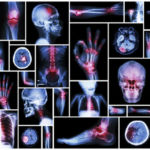By Ellen Lenox Smith, Columnist
Ellen Smith is a member of the Rhode Island EDS Support Group and very active as an advocate and speaker.
People living with Ehlers-Danlos Syndrome (EDS) are often afraid to go to a hospital emergency room, due to a lack of understanding in the ER staff on how to safely care for them. I myself recently had another negative experience, one that almost killed me.
In the process of being admitted, after passing out over and over due to low blood pressure, things went terribly wrong. While being transferred from the ambulance to the hospital stretcher, my hip was dislocated. This dislocation was unintentional, but avoidable, as it was a direct result of the rough manner in which the transfer was managed.
On top of this, they gave me no IV fluids for several hours, which should have been the first thing done to help elevate my blood pressure. Complicating matters even further, no food was brought to my room that I could safely eat and metabolize for the two days I was there.
And then, when a nurse thought I had stopped breathing, she compressed my chest to stimulate my heart, even though I was wearing two medical bracelets warning I shouldn’t be given chest compressions. Three months later, I am still paying for these mistakes.

As a result of my traumatizing and life threatening experience, I sent a letter to the hospital in the hopes of never having another EDS patient experience what I did. I was shocked to receive a call that resulted in the hospital taking me up on my offer to meet with their doctors and nurses to help them understand how to properly handle us.
To prepare for this meeting, I asked other EDS patients to submit suggestions to enhance my program. I hope that this list will be helpful to both patients and hospital staff.
How to Treat Ehlers-Danlos Patients
- Consider having a generic EDS protocol for staff to get a quick understanding of this condition with new patients.
- Put notes or a bulletin board or patient chart to share information and keep the patient safe from shift to shift.
- Be cautious, for EDS is an “invisible condition” so remember to do no harm. Understand that touching and moving us can create more problems, so listen to the patient. Tread lightly using chest compressions, because our ribs sublux, dislocate and break easily. Allow EDS patients to position themselves safely before any procedure.
- Subluxations are a real thing. Don’t just take a quick x-ray and tell us, “It’s nothing, you’re fine.” When a joint feels wrong, there’s an injury worth finding some relief for.
- Because we bruise easily, don’t rush to judgement with EDS children before reporting abuse.
- If someone arrives with an ID warning bracelet, please read and respect what is says!
- If a patient has low blood pressure, elevate their bed to a 30% angle. Hook up IV fluids quickly and approve the patient’s BP medication in time for their next dose. Consider using a PICC line if the IV does not hold.
- Many EDS patients are drug reactive, so respect if a DNA drug test has been done or listen to what medications have not worked in past. Pain relief is difficult to achieve with EDS so please believe the person.
- Some of us use compounded medications that need to be accepted in place of what you have in stock in the pharmacy. Some also use supplements, so please respect the use of them. Many are using the Cusack Protocol supplement routine.
- If a patient is using cannabis for pain control, consider allowing CBD use in the hospital in an oil, tincture, topical or pill form.
- Many of us are food reactive, so send your dietician to the room to meet the patient and create a safe meal plan.
- If a patient sleeps with CPAP or BPAP mask, be sure that it gets brought in and worn during sleep.
- Have on staff a physical therapist that can use manual energy techniques for re-alignment or allow an EDS manual therapist on the floor.
- If there is a need to draw blood, use a butterfly or small pediatric needle.
- If there is a need for intubation, be careful with movement of the neck and use small equipment. If an EDS patient presents with a neck fusion, do intubation using the fiber optic glidescope.
- If stitches are needed, try to using natural products over synthetic.
- Many of us have wound healing issues, so please be careful with the choice of tape and its removal. Some of us have skin that is fragile and easily tears.
- All types of EDS are at increased risk for scary vascular events. Any sudden or severe chest or abdominal pain needs a scan to rule out an aneurysm or another serious condition.
If surgery is needed, be sure to have your anesthesiologist do a pre-op interview before any procedures. Be careful about joint positioning and manipulation when performing anesthesia. Yes, that “jaw thrust maneuver” may make intubation easier or more comfortable, but it’s not worth the months of rehab from a dislocated jaw.
Please reassure your orthopedic residents that we’d prefer to avoid surgery, too. Having them share their fears out loud that they don’t want to operate on EDS patients because “that’ll just make things worse” may be true, but it’s not helpful. Nobody wants to feel like an untouchable leper. Instead, please focus on what you can do to help. It might be as simple as helping to reposition the joint to a more neutral spot, and then bracing or splinting it there to give things a rest before starting physical therapy
Ehlers-Danlos can be a very painful, isolating and heartbreaking condition to live with. We would love to come to a hospital for emergency help and not be afraid to be sent home in worse shape. Let’s all work to educate the medical field and improve the future for us all coping with this condition. May this list be a start for you!

Ellen Lenox Smith suffers from Ehlers Danlos syndrome and sarcoidosis. Ellenand her husband Stuart are co-directors for medical marijuana advocacy for theU.S. Pain Foundation and serve as board members for the Rhode Island Patient Advocacy Coalition.
For more information about medical marijuana, visit their website.
The information in this column should not be considered as professional medical advice, diagnosis or treatment. It is for informational purposes only and represents the author’s opinions alone. It does not inherently express or reflect the views, opinions and/or positions of Pain News Network.
Ellen Smith is a member of the Rhode Island EDS Support group.
Click here for the original source of this article
We appreciate your facebook Shares, Likes and comments.


